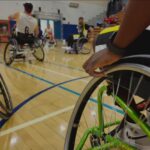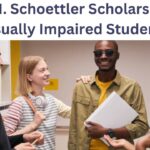I remember a time, not so long ago, when the dream of higher education felt like an insurmountable mountain for many young people I knew, especially those who navigated the world without the full symphony of sound. I’ve always been drawn to stories of resilience, of overcoming odds, and in my journey, I’ve met countless bright, ambitious deaf students whose spirits shone with an undeniable brilliance. Yet, beneath that glow, I often sensed a quiet anxiety – the worry of how they would ever afford the path to their aspirations. It wasn’t just about tuition; it was about specialized accommodations, interpreters, assistive technologies, and the myriad other costs that often go unmentioned when we talk about a "standard" college experience.
My own path led me to work closely with educational access programs, and it was there, amidst the bustling energy of hopeful students and dedicated educators, that I truly began to understand the unique financial hurdles faced by the deaf community when it came to pursuing college or vocational training. The whispers of doubt I heard weren’t about intellectual capability, but about practical possibilities. "How can I afford this?" was a question that echoed more often than I cared to admit. And that’s when I started digging, sifting through resources, talking to counselors, and learning about something truly transformative: scholarships specifically designed for deaf students.
It was like discovering a hidden network of helping hands, outstretched and ready to lift. I realized that the narrative didn’t have to be one of financial struggle alone; it could also be one of abundant opportunity. My mission, from that point on, became to share this knowledge, to illuminate the paths that often felt obscured by daunting financial figures.
Think about it for a moment: navigating the world as a deaf individual requires a unique set of skills and often, additional resources. Education, especially higher education, is no different. A classroom without an interpreter, a lecture hall without captioning, or a study group without accessible communication tools can quickly become an isolating and ineffective environment. These necessary accommodations, while fundamental for equal access, come with a price tag. This is where the beauty of targeted scholarships truly shines, not just covering tuition, but often assisting with those vital support services.
One of the first things I learned was that these scholarships aren’t a single, monolithic entity. They come from a diverse array of sources, each with its own focus and criteria. There are the broad, national organizations, the more localized community funds, and even specific university programs. It’s a tapestry woven with generosity and a deep understanding of the deaf experience.
I remember helping a young woman named Sarah. She was brilliant, an aspiring engineer, but her family’s income meant that even state university tuition was a stretch, let alone the specialized support she’d need. We sat down together, her eyes alight with a mixture of hope and trepidation, and began to explore the landscape of financial aid.
We started with the giants, the well-known institutions that have long championed deaf education. Gallaudet University, for instance, isn’t just a world-renowned university for deaf and hard of hearing students; it’s also a hub for various internal scholarships and financial aid programs tailored to its unique student body. For students like Sarah, considering a fully immersive ASL environment, Gallaudet often provides a comprehensive financial package. Similarly, the National Technical Institute for the Deaf (NTID) at Rochester Institute of Technology (RIT) offers its own suite of opportunities, recognizing the specific needs of deaf students pursuing technical and scientific fields. These institutions understand that the cost of education goes beyond tuition and often include support for interpreters, note-takers, and adaptive technologies. Their scholarship funds are often designed to bridge that gap.
But what if a student preferred a mainstream university? That’s where the search expanded. I discovered that many general disability scholarship programs also welcome applications from deaf students. Organizations like the American Association on Health and Disability (AAHD) or the National Center for Learning Disabilities (NCLD) sometimes offer scholarships that, while not exclusively for deaf students, certainly include them in their scope. These programs often look for students who demonstrate academic promise, leadership potential, and a commitment to their community, regardless of their specific disability. It’s about recognizing talent and potential, not just need.
Then there are the more specific organizations. I learned about the Alexander Graham Bell Association for the Deaf and Hard of Hearing (AG Bell), which provides scholarships to deaf and hard of hearing students who primarily communicate through listening and spoken language. Their awards often recognize academic excellence and a commitment to integrating into mainstream educational environments. This was particularly relevant for students who had grown up with cochlear implants or hearing aids and thrived in oral communication settings. On the other end of the spectrum, organizations like the National Association of the Deaf (NAD) sometimes offer scholarships that support deaf individuals pursuing higher education, often emphasizing leadership and advocacy within the deaf community. These specialized funds truly cater to the diverse ways deaf individuals identify and communicate.
I also stumbled upon corporate-sponsored scholarships. Companies, often those involved in hearing technology or related fields, sometimes create their own scholarship programs. For example, Cochlear Americas, a leading manufacturer of cochlear implants, has a scholarship program for students who use their devices. These kinds of scholarships are fascinating because they often tie into a company’s broader philanthropic goals and commitment to supporting their user community. It’s a win-win: students get funding, and companies reinforce their dedication to the people they serve.
As Sarah and I continued our research, we also found local community foundations and state-specific programs. Many states have vocational rehabilitation services that offer financial assistance for college, not just for tuition but also for necessary support services like sign language interpreters or assistive listening devices. These state programs are often overlooked but can be a huge resource, providing comprehensive support beyond just a single scholarship award. It’s about looking at the whole picture of a student’s educational journey.
Applying for these scholarships, I quickly learned, was an art in itself. It wasn’t just about filling out forms; it was about telling a story. Every application asked for essays, and this was where Sarah truly shone. I encouraged her to write not just about her grades, but about her experiences, her challenges, and how her deafness had shaped her perspective and fueled her determination. I told her, "Don’t just say you’re deaf; explain what that means for your journey, your insights, your unique contributions."
The essays often required a careful balance. Students needed to articulate their financial need without sounding like a sob story, to highlight their accomplishments without seeming arrogant, and to explain their goals with clarity and passion. I’d often advise them to focus on their resilience, their problem-solving skills, and how their lived experience as a deaf individual would bring a unique and valuable perspective to their chosen field. For Sarah, this meant writing about how her approach to problem-solving in engineering was influenced by her visual processing skills and her ability to think outside conventional auditory frameworks. It was powerful.
Letters of recommendation were another critical piece. I always urged students to seek out teachers, mentors, or community leaders who knew them well and could speak not only to their academic abilities but also to their character, their work ethic, and their potential to make a difference. A strong letter from someone who truly understands a deaf student’s journey can make all the difference, highlighting their perseverance and unique strengths in a way that grades alone cannot.
And then there’s the financial documentation. This can feel daunting, gathering tax returns, income statements, and household expense details. But it’s crucial. Scholarship committees need to understand the full financial picture to determine need. I always reminded students that this wasn’t about judgment, but about demonstrating eligibility. Transparency and thoroughness were key.
The process was undoubtedly time-consuming, sometimes frustrating, and occasionally felt like navigating a maze blindfolded. But the payoff? Immense. Sarah applied to several programs, meticulously crafting each essay, gathering every document. She faced rejections, as many students do, but she also received acceptances. One day, she burst into my office, a wide grin stretching across her face, clutching an acceptance letter and a scholarship award notification from a foundation dedicated to supporting women in STEM fields with disabilities. It wasn’t the full cost of her dream university, but it was a significant chunk, enough to make the seemingly impossible suddenly feel within reach.
Her story isn’t unique. I’ve seen it play out time and again. These scholarships aren’t just about money; they’re about validation. They send a powerful message: "We believe in you. Your education matters. Your contributions are valued." For deaf students who often navigate a world not always designed for them, this affirmation can be just as crucial as the financial support itself.
The impact of these scholarships extends far beyond the individual recipient. When a deaf student receives a scholarship, they are empowered to pursue their dreams, to contribute their unique talents to society, and to become role models for future generations. They break down barriers, challenge misconceptions, and enrich the diversity of thought and experience in every classroom and workplace they enter. An educated deaf individual isn’t just a success story; they’re a testament to what’s possible when opportunities are made accessible.
My advice to any deaf student or their family reading this is simple: start early, research thoroughly, and never give up. The resources are out there. Look beyond the obvious. Check with your high school counselors, vocational rehabilitation services, local deaf community centers, and online scholarship databases specifically tailored for students with disabilities. Don’t limit yourself to just one type of scholarship; cast a wide net. Some scholarships might be small, but many small scholarships can add up to a substantial amount.
And remember, your story is your power. The journey you’ve taken, the challenges you’ve overcome, the unique perspective you bring to the world – these are all assets in the scholarship application process. Don’t be afraid to share your authentic self, your aspirations, and your unwavering determination. The committees aren’t just looking for good grades; they’re looking for passionate individuals who will make a difference.
The path to higher education for deaf students may have its own set of particular complexities, but it is a path absolutely worth pursuing. With the growing awareness and the increasing availability of scholarships for deaf students, those once-daunting mountains are becoming a little less steep, and the doors to a brighter future are opening wider than ever before. My hope is that every deaf student who dreams of college knows that there are people and organizations out there ready and willing to help them turn that dream into a tangible reality. The journey might be long, but it’s a journey filled with incredible support, waiting to be discovered.



